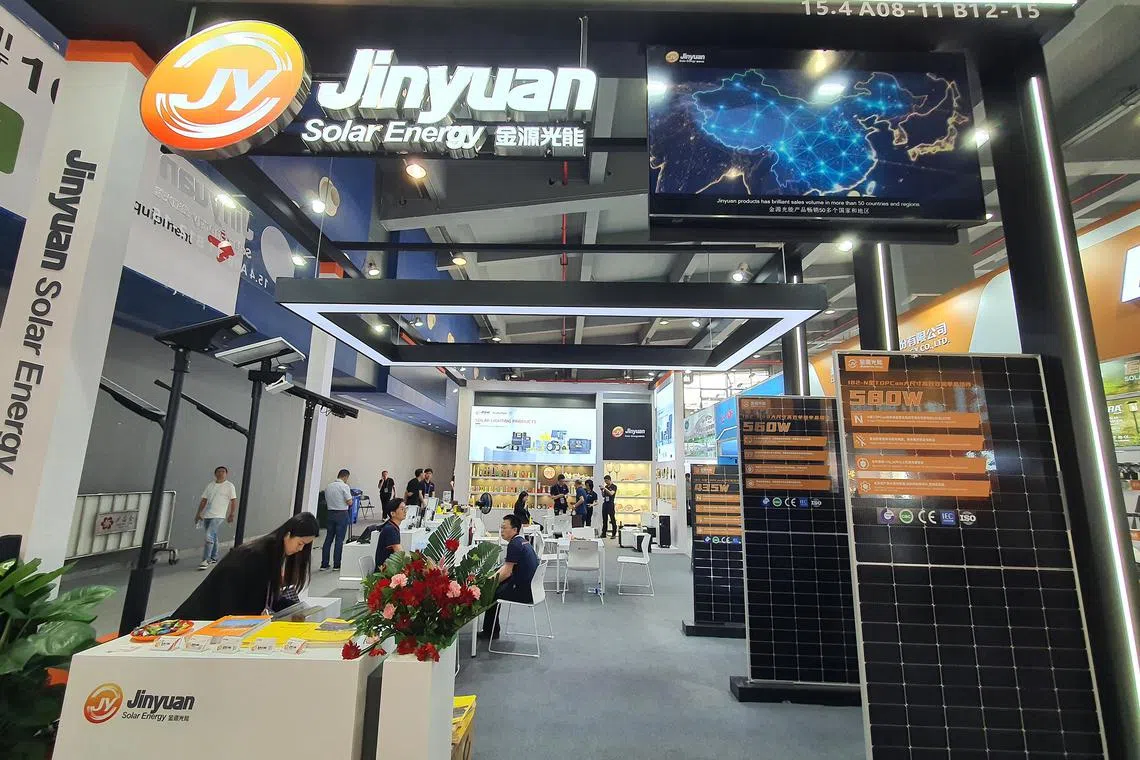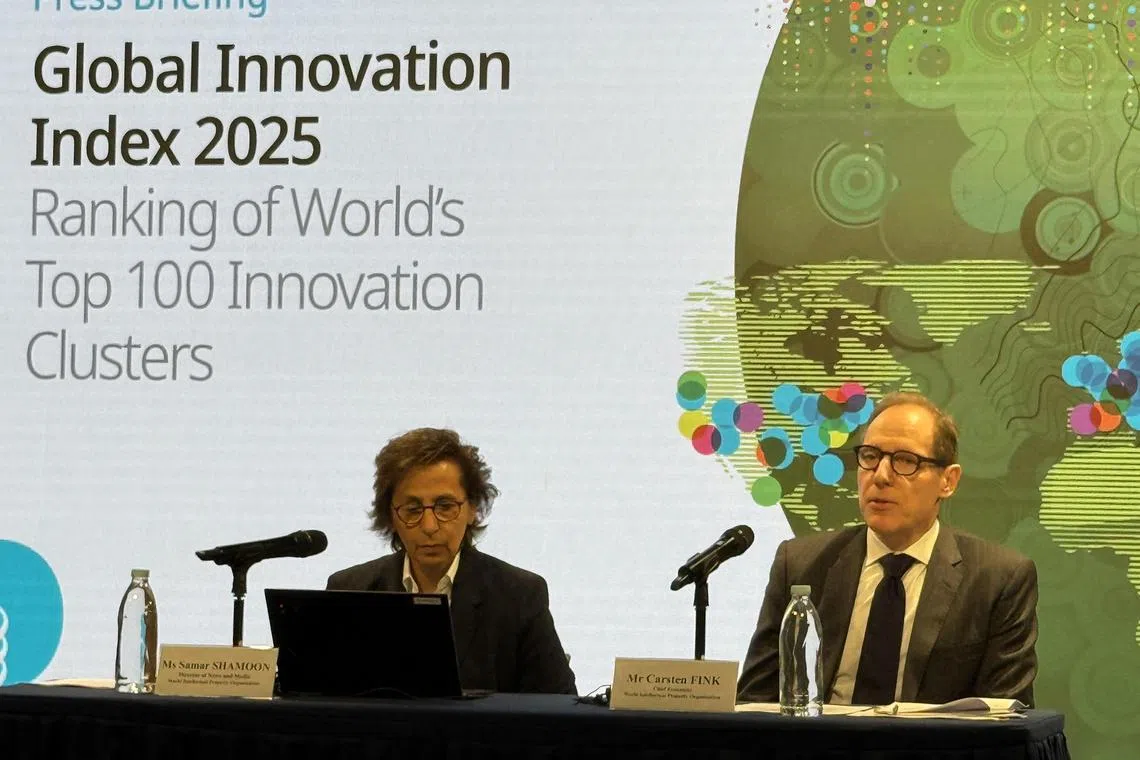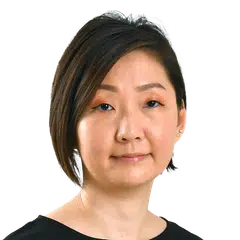HK, Shenzhen, Guangzhou named world’s top innovation hub; Singapore rises to 16th spot
Sign up now: Get ST's newsletters delivered to your inbox

Guangdong Jinyuan Solar Energy displaying its solar panels at the Canton Fair in Guangzhou, China. The world’s top 100 innovation clusters are spread across 33 economies.
PHOTO: ST FILE
Follow topic:
HONG KONG – A cluster of three Chinese cities comprising Hong Kong, Shenzhen and Guangzhou has topped a United Nations ranking of the world’s most innovative hubs.
The addition of venture capital deal activity as a new metric in the World Intellectual Property Organisation’s (Wipo) Global Innovation Index (GII) cluster study pushed the Shenzhen-Hong Kong-Guangzhou hub to the top spot in 2025, the agency said on Sept 1.
Japan’s Tokyo-Yokohama cluster, which topped the 2024 index, fell to second place. San Jose-San Francisco was third, with Beijing ranked fourth, and Seoul, fifth.
The new metric’s addition resulted in Singapore rising in the ranking as well, propelling it into the world’s top 20 most innovative hubs at 16th place. It was ranked No. 33 in 2024.
The Wipo GII cluster ranking, started in 2017, was previously based on only two key metrics – the numbers of international patent filings and scientific publications written by inventors and authors affiliated with the region.
With the third metric added in 2025 – the number of venture capital (VC) deals made by firms in the region – the latest study aims to give a more complete picture of how research translates into start-up creation as well as new goods and services in each economic cluster.
The results “highlight which clusters are turning scientific research into economic results”, according to Wipo director-general Daren Tang.
Wipo chief economist Carsten Fink attributed the Shenzhen-Hong Kong-Guangzhou cluster’s innovative success to its ability to use each city’s strengths in collaborating.
“Hong Kong is particularly well-known for its excellent scientific institutions and universities (while) a lot of the patenting that emerges out of company research development activities originates from companies in Shenzhen,” Mr Fink said at a press briefing on Sept 1.
“Many scientific ideas that emerged from Hong Kong led to start-ups across the border (in Shenzhen and Guangzhou). And there is venture capital deal activity on both sides of the border, for which Hong Kong is also an important source of financing.”

Wipo director of news and media Samar Shamoon and Wipo chief economist Carsten Fink speak ahead of the release of the United Nations agency's Global Innovation Index cluster rankings on Sept 1.
ST PHOTO: MAGDALENE FUNG
The cluster is part of the Greater Bay Area (GBA), a wide-ranging Chinese government initiative comprising Hong Kong, Macau and nine Guangdong cities aimed at integrating the disparate cities to foster greater economic growth and development
Financial Secretary Paul Chan said Hong Kong played a “pivotal role”, offering unique value in technology, capital and talent to achieve the cluster’s top ranking in the index.
“Together, we (in the GBA) are exceptionally well positioned to become one of the world’s most dynamic and influential innovation clusters,” he noted in his speech at an event releasing the results on Sept 1.
The Shenzhen-Hong Kong-Guangzhou hub’s achievement highlighted the GBA region’s “strategically important role in China’s scientific and technological innovation system”, said Professor Nancy Ip, president of the Hong Kong University of Science and Technology.
“It underscores the GBA’s role as a leading global performer in both innovation and economic impact,” she said.
She added that her university had “contributed significantly to the GBA’s growth story through high-impact patents... as well as an unparalleled record of nurturing unicorns, and incubators and programmes that empower tomorrow’s entrepreneurs”.
Wipo’s GII rankings, globally recognised as rigorous assessments of innovation concentration, offer governments, investors and researchers a valuable snapshot of regional strengths and potential partnerships.
The world’s top 100 innovation clusters are spread across 33 economies. By country, China led the ranking for the third straight year with the most hubs in the top 100, at 24 clusters; followed by the United States with 22.
Rankings for London as well as clusters in India – like Bengaluru, Delhi and Mumbai – improved compared with 2024, after accounting for their high VC deal activity. Hubs in the European Union fared worse due to their less vigorous VC markets.
By innovation intensity, which takes into account population size, the San Jose-San Francisco cluster came tops, followed by Britain’s Cambridge, then Boston-Cambridge in the US.
By that measure, the Shenzhen-Hong Kong-Guangzhou region ranks 45th for having filed 2,292 applications under Wipo’s patent cooperation treaty (PCT), published 3,775 scientific articles, and inked 135 VC deals per one million inhabitants in the recent five years. Tech giants Huawei, Oppo and ZTE were its top patent applicants.
In comparison, Singapore is in 33rd place for having filed 707 PCT applications, published 4,532 scientific articles, and inked 527 VC deals per one million inhabitants. The National University of Singapore, R&D statutory board A*Star, and Nanyang Technological University were the city’s top patent applicants.
Singapore’s top collaborating location was the Shenzhen-Hong Kong-Guangzhou region, while the latter’s top collaborating clusters were Beijing and Shanghai-Suzhou.
A separate GII ranking of individual cities will be released on Sept 16.
Dr Zhou Lihan, CEO of Singapore’s Hong Kong-listed billion-dollar biotech start-up Mirxes
He noted, however, that in Singapore, “publicly funded institutes of higher learning dominate both scientific publications and patent applications, in contrast to the Chinese and US clusters, where more patent applications originate from industry players”.
“Policies and programmes that help speed and scale up the privatisation and commercialisation of these patents and publications will be necessary for the long-term sustainability of our heavily publicly funded innovation ecosystem,” Dr Zhou said.
Dr Zhou’s firm, Mirxes, a spin-off from A*Star, invented and produces the world’s first blood test kit to detect early stage gastric cancer.
Both Singapore and the Shenzhen-Hong Kong-Guangzhou clusters can ensure continued success by adhering to the core principles of open, borderless innovation and international collaboration, the CEO said.
“It can be challenging to navigate current geopolitical complexities, but there is also an opportunity for further integration of Asian innovation clusters, especially in addressing specific Asia-centric challenges like diseases of Asian prevalence,” he added.


